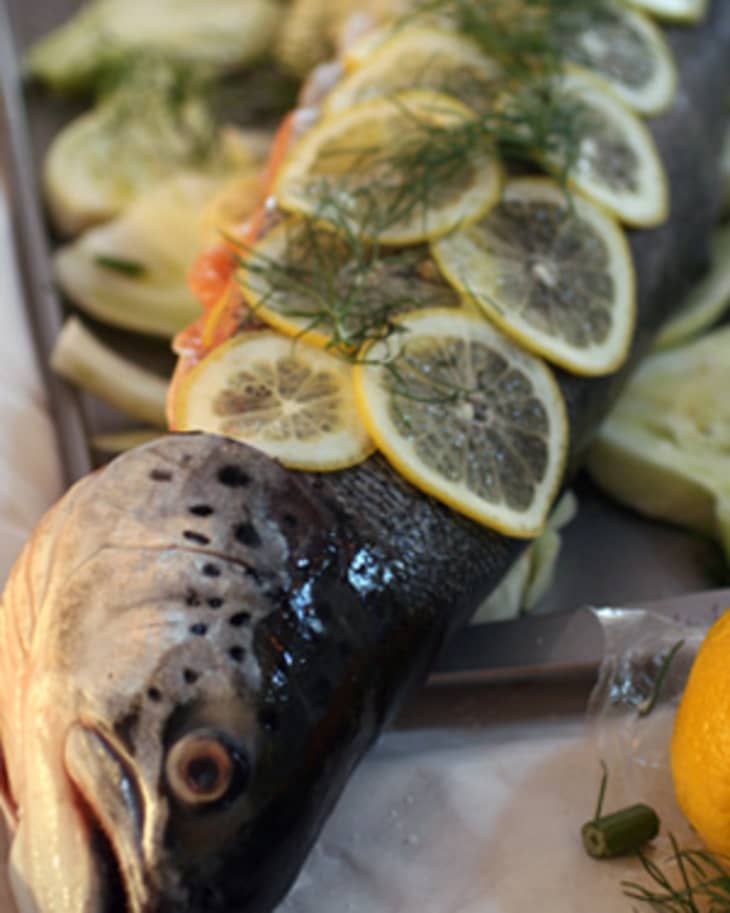How to Cook a Whole Fish
My adventure with this big fish peaked as I tried shoving it — lovingly stuffed and carefully sewn up with pink thread — into my twenty-inch apartment-sized oven. There was swearing and a little dance of frustration. Maybe even a lump in the throat. Then I hacked it in half and moved on.
It turns out the easiest part of making a whole fish is prepping and roasting it. The tricky part is finding a fish that doesn’t come with a complicated load of environmental and health baggage, and salmon is no exception.
Wild Alaskan salmon is as politically correct as you can get since the farmed stuff ranks very low on the list of sustainable seafood. Red snapper is commonly cooked whole, but also ranks low unless you’re catching it yourself in certain parts of Hawaii. Trout, bass and small fish like sardines are good choices. To stay on top of the latest in seafood sustainability, use one of the online guides from the Monterey Bay Aquarium, the Blue Ocean Institute, or the Natural Resources Defense Council and make an informed choice and know that these lists are constantly shifting.
Salmon is hard to find whole in a regular market; wild Alaskan salmon is even more difficult. But if you make friends with your fishmonger, you can usually arrange something. The smaller guys like trout, bass and sardines are easier to find. Sardines are really a miracle fish: good for you, easy on the seas, and they cook before you have time to blink.
If you find yourself blessed with a whole fish, follow a few simple steps and you’ll have an impressive presentation. (Kissing the fish on the mouth, or anywhere for that matter, is optional.)
How to Cook a Whole Fish
Each pound of whole fish roughly yields one and a half servings
- Start with a cleaned, possibly de-boned fish. Some fish are better cooked with their bones in. Ask your fishmonger.
- Preheat the oven to between 350°F and 450°F. The bigger the fish, the higher the temperature.
- Rub the fish, inside and out, with olive oil and sprinkle with salt and pepper.
- Stuff the fish, if desired. (Small fish like sardines are better served with a external sprinkling of, say, chopped garlic and parsley rather than a stuffing.) A variety of things work: very thin citrus slices, fennel, whole herb sprigs, sliced olives, sliced garlic, caramelized onions, sliced tomatoes, etc.
- If the fish is large and does not lay flat as if it weren’t stuffed, sew up the cavity using a trussing needle and twine, or with toothpicks spaced about an inch apart.
- If the fish is too big for your oven, slice it in half crosswise right up to the stitches, leaving them intact.
- Place the fish on a roasting pan lined with parchment paper or olive-oil rubbed sliced vegetables (fennel and onions work best) and rub the outside with a little more olive oil. Give it another sprinkling of salt and pepper.
- Cooking time can be anywhere from one hour for a large fish like my eight-pounder, to just 10 minutes for small fish like a sardines. A typical 1-2 pound single serving fish like trout or branzino might take 20-30 minutes at 400°F. Midway through, pour a bit of white wine into the pan. To test for doneness, use an instant-read thermometer on large fleshly fish like my salmon (aim for 130°F) and for smaller fish like trout, simply cook until the flesh flakes easily when poked with a fork.
- To serve larger fish, slice crosswise into portions (we took ours on a picnic in parchment paper, below) or carefully peel back the skin and lift out pieces from each side with a spatula. To serve smaller fish, bring to the table whole, providing a fork and knife. Watch for bones.
It’s Reader Request Week at The Kitchn! This post was requested by Janet Brandt.
(Originally published 2010-05-13)
(Images: Sara Kate Gillingham-Ryan)
